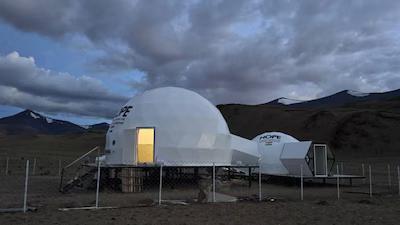
ISRO Sets Up Station in Ladakh to Simulate Life on Moon & Mars
As India continues to push the boundaries of space exploration, the Indian Space Research Organisation (ISRO) has taken a significant step forward in its mission to explore the lunar and Martian surfaces. In a groundbreaking initiative, ISRO has set up the Himalayan Outpost for Planetary Exploration (HOPE) in Ladakh’s Tso Kar Valley, a region that is eerily reminiscent of the harsh Martian environment.
Located at an altitude of 15,000 feet, the Tso Kar Valley was chosen for its unique combination of extreme conditions that are similar to those found on Mars. The valley is characterized by high UV radiation, low atmospheric pressure, extreme cold, and saline permafrost – all of which are critical factors that ISRO must consider when planning its lunar and Martian missions.
The HOPE station is designed to simulate the life-support systems that will be needed for future missions to the Moon and Mars. The station is equipped with state-of-the-art facilities that will test the endurance of the crew, as well as the equipment and systems that will be used on the missions.
For the next 10 days, starting August 1, two crew members will undertake various tests at the HOPE station to assess the feasibility of life-support systems for lunar and Martian missions. The crew will be living in the harsh environment, experiencing temperatures as low as -20°C and dealing with limited resources, all while carrying out various tasks and experiments.
The crew members will be tasked with testing the air supply, water recycling systems, and communication equipment, among other things. They will also be conducting experiments to simulate the effects of space travel on the human body, as well as testing the psychological effects of isolation and confinement.
The HOPE station is a crucial step forward in ISRO’s mission to send humans to the Moon and Mars. By simulating the conditions that astronauts will face on these missions, ISRO can identify and address potential issues before they become major problems. The station will also provide valuable insights into the psychological and physical effects of long-duration space travel, which is essential for planning future missions.
The choice of the Tso Kar Valley as the location for the HOPE station is not accidental. The region’s unique combination of extreme conditions makes it an ideal location for testing equipment and systems that will be used on Martian missions. The valley’s high UV radiation, for example, is similar to the intense radiation that astronauts will face on Mars, while the low atmospheric pressure and extreme cold will test the endurance of the crew and equipment.
The HOPE station is also an important milestone in ISRO’s plans to establish a human settlement on the Moon and Mars. The organization has already announced plans to send humans to the Moon by 2024 and to establish a permanent human settlement on the lunar surface by 2025. The HOPE station is a critical step towards achieving these goals, as it will provide ISRO with the necessary expertise and infrastructure to support long-duration space missions.
In conclusion, the HOPE station in Ladakh’s Tso Kar Valley is a significant milestone in ISRO’s mission to explore the Moon and Mars. The station will provide valuable insights into the feasibility of life-support systems for lunar and Martian missions, as well as identify and address potential issues before they become major problems. As India continues to push the boundaries of space exploration, the HOPE station is an important step forward in the country’s quest to become a major player in the global space industry.






